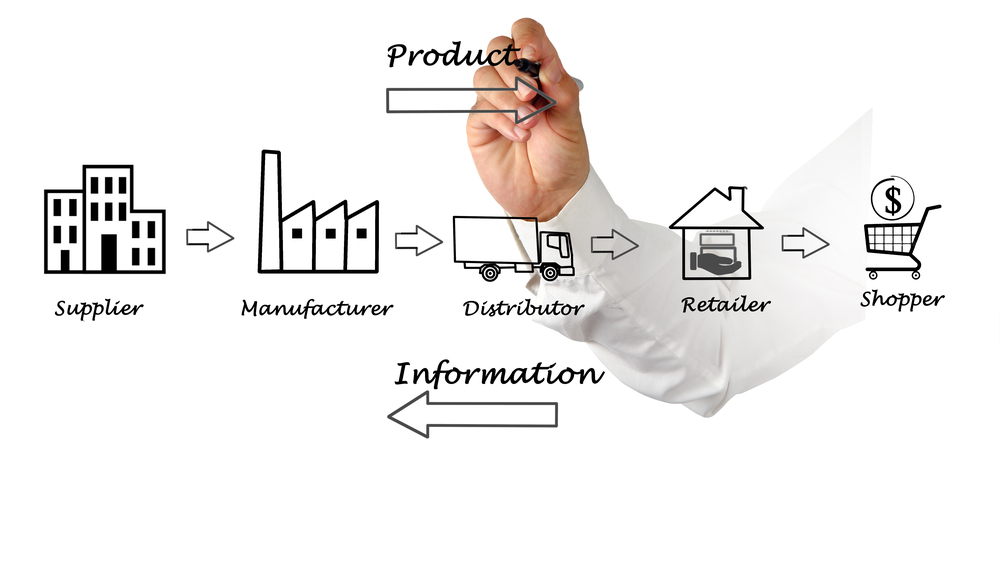Owning a warehouse or other organization that deals in procurement or order fulfillment means that you have a hand in the supply chain. In order to better serve your customers, you must make the supply chain part of your business strategy seamless. Furthermore, you need to be prioritizing supply chain management. This means figuring out how to enhance the productivity and efficiency of your business so that everything runs smoothly and is delivered without delay. That is not easy to master, which is why you need to know about the basic components of supply chain management, as well as how specific technologies can help you along the way. Let’s get started.
What is a Supply Chain?
The supply chain is expansive, as it includes organizations, people, information, products, and resources that move from one point to the next until it reaches the hands of the consumer. The spans the procurement of raw materials, production, packaging, storing or warehousing, shipping, delivery, and retail.
What is Supply Chain Management?
The Chartered Institute of Procurement and Supply (CIPS) states that supply chain management (SCM) is “the handling of the flow of goods and services from the raw manufacturing of the product through to the consumption by the consumer.” In other words, supply chain management is supply and demand management, as well as managing the processes that keep the supply chain moving not just within your organization but across all channels and among all members.
There are many technological advancements that make supply chain management a little less confusing and time-consuming, including enterprise resource planning (ERP) and warehouse management system (WMS) solutions. You can unlock a lot of potential by looking at your business in real-time, managing inventory movement, and forecasting supply and demand trends.
Why is Supply Chain Management Important?
Let us take a moment to consider why you need to manage the supply chain. When an organization has poor SCM practices, the result can be quality issues, expensive delays and mistakes, and a damaged reputation among distributors and customers. Should there be a legal issue, poor supply chain management could end up showing non-compliance with various rules and regulations.
Excellent SCM, on the other hand, allows you to:
- Anticipate inventory levels and potential problems in advance
- Improve inventory and fulfillment processes
- Adjust your pricing for maximized profitability
- Speed up your warehouse or distribution center for enhanced order fulfillment
Basic Components of Supply Chain Management
Now that you know the basic definition of supply chain management, here are the five basic components:
1. Planning
To meet the needs of the distributor or the customer, you need to plan ahead. Even if your business is one small piece of the supply chain, preparation is necessary to stay ahead of demand. This is where planning comes into play. You must determine how your organization affects the supply chain and then figure out the best way to maintain a level of efficiency, all the while delivering consistent value to your customers.
One of the best ways to do this is with the combined forces of a WMS and ERP. As inventory comes and goes from a warehouse, for example, the SKU or barcode is scanned. Inventory levels are automatically updated, and that information is shared with the integrated ERP. From there, you can analyze the data, forecast demand, and order the materials or products you need to meet the needs of consumers in the future.
2. Sourcing
Part of supply chain management is selecting who gets what. Even in the warehouse or distribution center, you must oversee order transactions, manage inventory flow, authorize payments, and, sometimes, send out EDIs and advanced shipping notifications when there is an expected delay.
3. Making
If your organization handles food, beverages, or chemicals of some kind, then you need SCM to ensure the traceability and validity of every single item. Supply chain management ensures that the materials used in a box of cereal, for instance, have been received, accepted, and then processed, shipped, stored, and delivered according to strict regulations.
From a warehousing standpoint, utilizing barcodes and using a WMS for validation and traceability is one way to automate this component of SCM.
4. Delivering
Logistics and supply chain management go hand-in-hand. Coordinating orders, picking and packing, scheduling deliveries, invoicing, dispatching, notifying, and receiving payments are crucial. Even with third-party courier systems, every single exchange along the way needs to be carefully monitored to ensure there are no errors or delays.
5. Returning
Supply chain management also entails developing networks that make returning products easier and quicker. This includes figuring out how to repurpose the item, whether that include reproduction, scrapping, or returning the product to the shelf in a warehouse. SCM is more than responding to supply and demand, it is about being flexible and meeting the customer’s needs.
Keep The Supply Chain Moving with a WMS
Knowing the basic components of supply chain management is an essential piece of the puzzle when developing strategies to keep your organization running smoothly. The bottom line is that the supply chain is critical, and so decisions you make have to benefit it. One of the first steps is to incorporate software into your organization that accounts for the supply chain while enhancing your business’s overall productivity, such as a warehouse management system like Agility WMS from WiSys.
Our out-of-the-box solution can also be fully customized to suit the unique needs of your organization, be it a small drop-shipping warehouse or a multi-location enterprise. Give WiSys a call today at 770-955-3530 or schedule a demo online.


